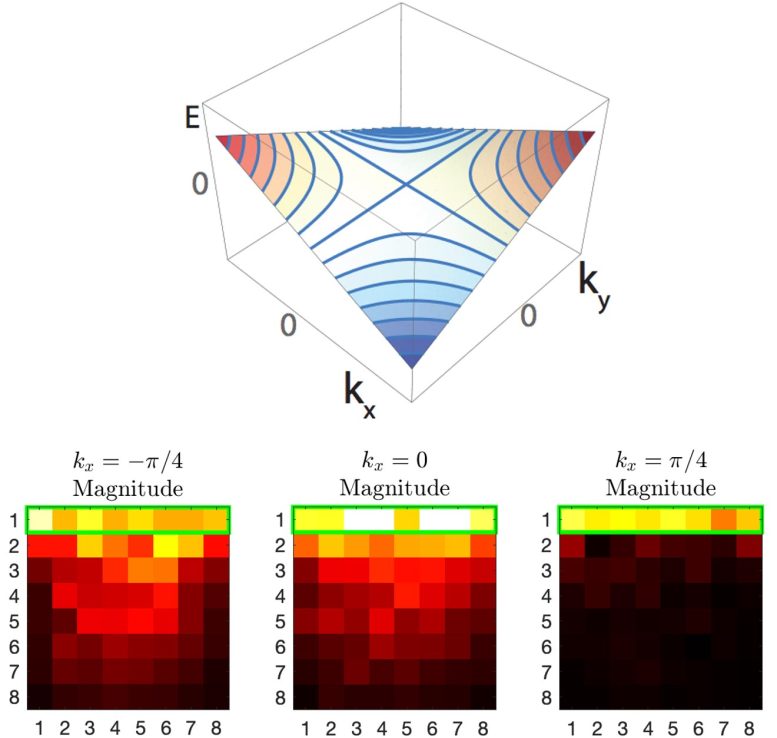
(Above) Dispersion surface for a rank-2 chiral material. (Below) Experimental measurements from a rank-2 circuit metamaterial. Credit: The Grainger College of Engineering at the University of Illinois Urbana-Champaign
A team at the University of Illinois Urbana-Champaign has demonstrated a new form of two-dimensional chiral flow, called rank-2 chirality, using a topological circuit network. This breakthrough could pave the way for innovative devices in filtering flows, optical beam engineering, and microelectronics.
It is often desirable to restrict flows—whether of sound, electricity, or heat—to one direction, but naturally occurring systems almost never allow this. However, unidirectional flow can indeed be engineered under certain conditions, and the resulting systems are said to exhibit chiral behavior.
The concept of chirality is traditionally limited to single direction flows in one dimension. In 2021, however, researchers working with Taylor Hughes, a professor of physics at the University of Illinois Urbana-Champaign, introduced a theoretical extension that can account for more intricate chiral flows in two dimensions. Now, a team led by Hughes and Gaurav Bahl, a UIUC professor of mechanical science and engineering, has experimentally realized this extension. As the researchers reported in the journal Nature Communications, they constructed a topological circuit network, a system of electronics that simulates the microscopic behavior of quantum materials, to explore the entirely new behaviors predicted by this extended, or higher-rank chirality.
“In effect, we have generalized the idea of a one-way street into two dimensions,” Hughes said. “In two dimensions there is no absolute sense of something going one way or the other, but if you carry around a fixed arrow with you, then you can still describe chiral motion relative to that arrow.”
Indeed, higher-rank chirality manifests as locking between a particle’s flow direction and the direction of an arrow, or vector quantity, that it carries along with it. For this study, the team focused on rank-2 chirality where the flow is locked to be transverse to the momentum vector carried by the particles. Penghao Zhu, the study’s lead author and a UIUC physics graduate student, explained, “In standard chirality, flows can only go one way—to the right, let’s say. However, a rank-2 system is designed so that if a particle’s momentum is up, then it flows to the right, and if the momentum points down, then it flows to the left.”
In the 2021 study, Hughes’ group proposed a quantum material system for rank-2 chirality, but their interdisciplinary team realized they could explore the behaviors of this system with a topological circuit network instead. On this platform, chirality is a consequence of microscopic dissipation or friction, called non-Hermiticity, that has been engineered to only impact flows in particular directions such that unwanted flows die off quickly, leaving only flow in the desired direction.
Zhu and postdoctoral fellow Xiao-Qi Sun designed a circuit network that exhibits the needed non-Hermiticity, and they collaborated with Bahl to construct this “meta” material and perform experimental measurements. According to Zhu, the material displayed an important signature of chiral systems: the non-Hermitian skin effect, where the imposed unidirectionality makes the flow accumulate on the system’s boundary.
“Moreover, our experiment displays new phenomena that have not been previously explored, like corner localization, where the flows accumulate at the material corners,” he said. “This is something very special to rank-2 chirality and cannot be seen in any skin effect that has been previously demonstrated.”
The generalizations offered by higher-rank chirality suggest a new class of devices that could be used to filter flows and engineer optical beams. Sun imagines a device that separates photons, or particles of light, based on the direction they travel: if only the photons traveling to the right are desired, then a rank-2 chiral material could remove the leftward propagating photons by forcing them into a different direction to be discarded.
“Another useful mapping of this idea could be made to semiconductor electronic devices, where new and unique filtering operations may be accomplished with electrons,” Bahl said. “Pretty much every electronic computation and communication device that we use today relies on controlling the flow of electrons. If we are able to replicate this higher-rank chiral behavior in microelectronics, a behavior that we’ve never had access to before, it could lead to some transformative new applications.”
Sun added that the true reward of studying higher-rank systems is a deeper understanding of what is possible.
“By designing and constructing systems that extend our understanding, we are taking the first step towards a much more generalized universe,” he said.
Reference: “Higher rank chirality and non-Hermitian skin effect in a topolectrical circuit” by Penghao Zhu, Xiao-Qi Sun, Taylor L. Hughes and Gaurav Bahl, 9 February 2023, Nature Communications.
DOI: 10.1038/s41467-023-36130-x

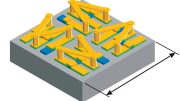
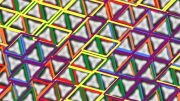


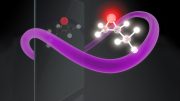

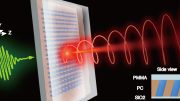

These event horizons can really cause so.expiermental controversy. Whom ever caught such a thing must be very lucky ,proud, and very intillectually intuitive to her surroundings